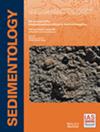Effects of sodium and potassium concentrations on dolomite formation rate, stoichiometry and crystallographic characteristics
IF 2.8
2区 地球科学
Q1 GEOLOGY
引用次数: 0
Abstract
This study uses high temperature (215°C) dolomitization experiments to explore the effects of sodium (Na) and potassium (K), two common constituents of natural fluids, on dolomite formation rate, stoichiometry and crystallographic characteristics. In these experiments, aragonite ooids were dolomitized in Mg–Ca–Cl solutions with either no additional salt, or in solutions containing NaCl or KCl at different concentrations. Results show that Na solutions, and to a lesser extent K solutions, correlate with faster reaction rates and that Na at hypersaline fluid concentrations produces dolomites with higher stoichiometry, higher micro‐strain and lower cation ordering. Potassium has a different effect on the dolomite than Na at similar concentrations. Unlike Na, K does not cause micro‐strain but leads to dolomite with smaller unit cell parameters. It is proposed that Na and K catalyse dolomite precipitation and increase stoichiometry by weakening Mg hydration bonds which consequently facilitates Mg incorporation into dolomite. The decrease in dolomite cation ordering at higher Na concentrations may stem from the incorporation of Na into dolomite which strains the crystal lattice and reduces cation order. On the basis that high‐temperature experiments are applicable to natural dolomites, several implications pertinent to natural dolomites are drawn from the results. Firstly, the data suggest that the higher concentrations of Na and K in evaporative fluids (i.e. higher salinity) can explain why dolomite is generally more abundant and more stoichiometric in evaporative settings. Secondly, the results challenge a key prediction of the mixing zone dolomitization model by showing that higher Na and K concentrations increase, rather than decrease, both dolomitization rate and stoichiometry. Thirdly, the observed decrease in dolomite cation ordering with increasing Na and K concentrations implies that evaporative fluids would produce less stable dolomite that may be more prone to subsequent recrystallization and thus resetting of primary geochemical signatures.钠和钾浓度对白云石形成速率、化学计量学和晶体学特征的影响
本文章由计算机程序翻译,如有差异,请以英文原文为准。
求助全文
约1分钟内获得全文
求助全文
来源期刊

Sedimentology
地学-地质学
CiteScore
8.20
自引率
11.40%
发文量
94
审稿时长
6-12 weeks
期刊介绍:
The international leader in its field, Sedimentology publishes ground-breaking research from across the spectrum of sedimentology, sedimentary geology and sedimentary geochemistry.
Areas covered include: experimental and theoretical grain transport; sediment fluxes; modern and ancient sedimentary environments; sequence stratigraphy sediment-organism interaction; palaeosoils; diagenesis; stable isotope geochemistry; environmental sedimentology
 求助内容:
求助内容: 应助结果提醒方式:
应助结果提醒方式:


